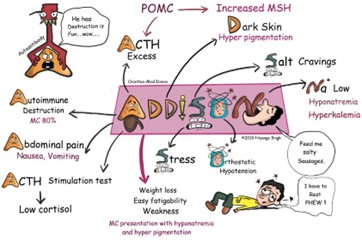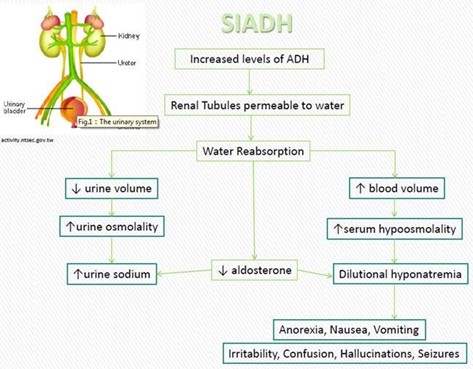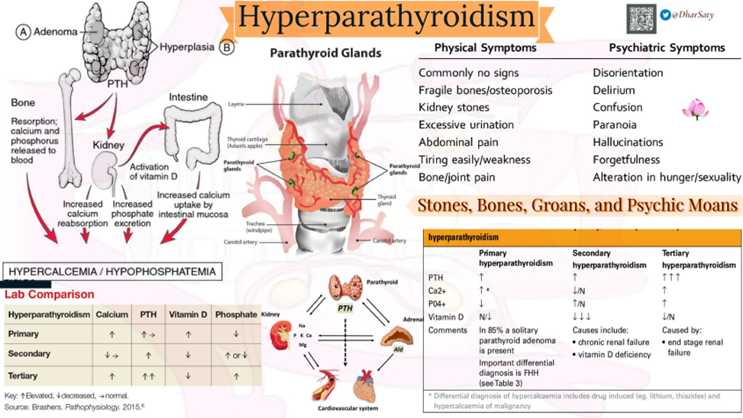A patient is hospitalized with acute adrenal insufficiency. The nurse determines that the patient is responding favorably to treatment on finding:
Decreasing serum sodium
Decreasing blood glucose
Decreasing serum potassium
Increasing urinary output
The Correct Answer is D
One of the hallmarks of adrenal insufficiency is dehydration and decreased urinary output, which can lead to electrolyte imbalances such as hyperkalemia and hyponatremia. As treatment begins to take effect, the patient's fluid and electrolyte balance should improve, leading to an increase in urinary output. Acute adrenal insufficiency, also known as the Addisonian crisis, is a life-threatening condition caused by a sudden decrease in cortisol and aldosterone hormones. Treatment usually involves the administration of intravenous glucocorticoids and mineralocorticoids to replace the deficient hormones.
Decreasing serum sodium (a) and decreasing blood glucose (b) are not signs of improvement but rather indicative of continued adrenal insufficiency. Decreasing serum potassium (c) is also not a sign of improvement as it could indicate that the patient is developing hyperkalemia, which is a potential complication of adrenal crisis.

Nursing Test Bank
Naxlex Comprehensive Predictor Exams
Related Questions
Correct Answer is C
Explanation
The correct answer is c. I will eat foods high in potassium because the diuretics cause potassium loss.
Rationale for Choice A:
- Statement:"I should weigh myself daily and report any sudden weight loss or gain."
- Rationale:This statement is correct.It's crucial for patients with SIADH to monitor their weight daily as even slight fluctuations can signal fluid imbalances.Sudden weight gain can indicate fluid retention,while sudden weight loss might suggest dehydration.Both scenarios warrant medical attention.
Rationale for Choice B:
- Statement:"I need to limit my fluid intake to no more than 1 quart of liquids a day."
- Rationale:This statement is also correct.Fluid restriction is a cornerstone of SIADH management.By limiting fluid intake,patients can help prevent the buildup of excess fluid in the body,which can lead to complications such as hyponatremia (low sodium levels in the blood) and edema.
Rationale for Choice C:
- Statement:"I will eat foods high in potassium because the diuretics cause potassium loss."
- Rationale:This statement is incorrect.While some diuretics used in the treatment of SIADH can indeed cause potassium loss,this is not a universal side effect.Furthermore,increasing potassium intake without medical supervision can be dangerous,potentially leading to hyperkalemia (high potassium levels in the blood).It's essential for patients to consult with their healthcare providers for individualized guidance on potassium intake.
Rationale for Choice D:
- Statement:"I need to shop for foods that are low in sodium and avoid adding salt to foods."
- Rationale:This statement is correct.A low-sodium diet is often recommended for patients with SIADH to help manage fluid balance and prevent hyponatremia.Restricting sodium intake can reduce fluid retention and help maintain appropriate sodium levels in the blood.

Correct Answer is C
Explanation
The patient with primary hyperparathyroidism has high levels of calcium in the blood (hypercalcemia) which can lead to symptoms such as kidney stones, bone pain, and weakness. High urine calcium levels may also be present due to the increased calcium in the blood.
One important intervention for managing hypercalcemia is to encourage fluid intake to promote increased urine output and prevent the formation of kidney stones. Therefore, the nurse should encourage the patient to drink at least 4000 ml of fluids per day.
Seizure precautions (a), range-of-motion exercises (b), and monitoring for positive Chvostek’s or Trousseaus sign (d) are not directly related to managing hypercalcemia and are not necessary in this case.

Whether you are a student looking to ace your exams or a practicing nurse seeking to enhance your expertise , our nursing education contents will empower you with the confidence and competence to make a difference in the lives of patients and become a respected leader in the healthcare field.
Visit Naxlex, invest in your future and unlock endless possibilities with our unparalleled nursing education contents today
Report Wrong Answer on the Current Question
Do you disagree with the answer? If yes, what is your expected answer? Explain.
Kindly be descriptive with the issue you are facing.
